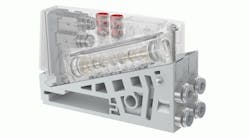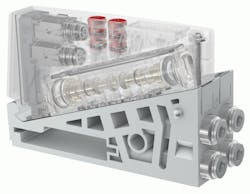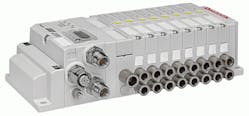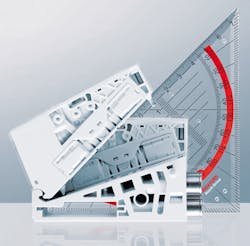Energy-efficient pneumatic circuit design often involves mounting valves as close as possible to the actuator. Reducing the length of tubing between a valve and actuator — and with it the volume of compressed air required for each actuator cycle — can cut compressed air consumption by as much as 20%.
Unfortunately, common pneumatic valves are usually too large and heavy to mount near the actuator in handling applications, where cylinders, grippers, or vacuum cups sit on a moving arm or gantry. A valve bank’s added mass could reduce the arm’s speed and load capacity, and possibly affect positioning accuracy. Or it might require more-powerful drives and more-massive structures, negating any benefits of decentralized pneumatics and increasing energy consumption of the overall machine.
Engineers at Bosch Rexroth reportedly have overcome these issues with their new AV03 valve. The AV03 offers high flow in a package lighter and more compact than traditional air valves. This makes it especially suited for handling equipment and other applications where the pneumatic hardware moves.
Cutting weight and size
Compared to conventional valves, the AV03 valves are half the weight, attributed to using high-performance polymers and reducing the number of parts, explains Marchelle Forish, senior product specialist at Bosch Rexroth Pneumatics, Lexington, Ky. The valve housing is made of glass-fiber-reinforced polyamide, which is substantially lighter than aluminum and other common valve materials. The polymer material also offers higher resistance to attack from chemicals compared to aluminum manifolds.
In addition, the valve’s size has been reduced 45% by orienting the spool at an angle within the housing. Mounting internal components diagonally makes optimum use of internal space, says Forish, letting engineers pack more functions into a smaller area. Working ports are only on the side where needed, and the valve has a smaller footprint, useful for base-plate mounting.
The design also uses fewer parts than previous versions. For example, only a single tie rod is needed for manifold assembly and a single screw for valve mounting. This eliminates one or two tie rods (depending on the series) and one fastener for each valve. It also speeds installation or replacement. The AV03 also has integrated pilots, further reducing the amount of mounting hardware.
Enhanced flow
Despite the smaller size, the AV03’s flow capacity actually matches or exceeds that of most competing valves. That’s because arranging internal components at an angle also gave developers the opportunity to streamline the supply and exhaust channels and reduce flow losses.
The angle design accommodates larger air channels, which permits higher flow in less space, explains Forish. “The improved channel geometry helps to avoid turbulent flows and pressure losses, as you use only the pressure needed,” Forish says. Every turn, throttle, and constriction reduces the pressure. The sharper a turn, the greater the reduction in working pressure.” The company’s R&D engineers used software simulation tools to design the channels and minimize pressure drops in the AV03, compared to similar, conventional valves.
“As a result, a lower working pressure can be set upstream of the valve system,” says Forish. The same cylinder force results, yet flow improves by 40%, allowing a substantially lower supply pressure for higher energy efficiency, adds Forish.
Configuration options
The AV03 is a zero-overlap spool valve with soft sealing, and the series includes 2×3/2-way, 5/2-way, and 5/3-way versions. Users can customize the number and type of valves to meet specific requirements. With a 25-pin D-sub connection, manifolds can be configured in increments of one after the second valve and after the fourth valve with 44-pin D-sub and fieldbus connections. The AV03 can control up to 24 coils with a 25-pin D-sub connection, up to 40 coils with a 44-pin D-sub, and up to 128 coils with a fieldbus connection. Designers can also opt for different pressure zones within a single valve manifold.
Users can electrically connect valve blocks using multi pole or fieldbus connections with integrated I/O modules, depending on the configuration. And because sensors can directly connect to the valve electronics, fewer cables have to be fed back to the control cabinet.
Maximum nominal flow is 300 lpm, with operating pressure ranging from -0.9 to 10 bar. Medium/ambient temperature is -10° to 60°C, and maximum allowable contaminant particle size in the compressed air is 40 μm. Protection class rating with an electrical connector/plug is IP-65.
Information for this article was provided by the Pneumatics Div. of Bosch Rexroth Corp. These products are now available through Aventics. Click here for more information on the Aventics AV03 valve.




